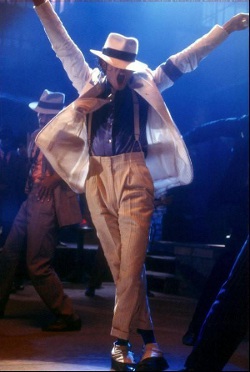When Michael Jackson died in June 2009, I was attending a three-week learning symposium/writing workshop for dance critics run by the National Endowment for the Arts at Duke University — an honor. This dance-criticism “Institute,” staged annually at the American Dance Festival (the NEA institutes are now defunct, we can’t afford ’em any more; our nation is too poor), gathered specialists who care and think deeply about dance as an art form.
One early evening after class, we learned via the Internet that MJ had died. Fifteen minutes later, extremely distressed, I shocked myself (and my flat mate) by heaving onto my bed and sobbing. Deeply affected, as well, were several other writers in our group.
You would assume that Michael Jackson, dancer, would be the subject of our workshop discourse — although “untrained,” he was one of the twentieth century’s greatest dancers, responsible for putting more eyes on the moving body than every ballet company combined, and here we had all been living concurrent to him. But the following day there was barely mention of his death — the minimum. Instead, we plodded through our daily dissection of the greats — Merce Cunningham, Mark Morris, and whomever was the new kid on view at The Kitchen.
MJ’s messy personal problems, yes, off putting. But frankly, it’s the “pop” in the King of Pop’s royal title that put him beyond our critical consideration.
Michael Jackson, I am so very sorry that the dance establishment to which I am attached does not appreciate or acknowledge the power of the way you moved your body, or its allure and influence. Recently viewing “This is It,” Kenny Ortega’s aptly named rehearsal documentary, and seeing the way music and movement poured from your slender frame as naturally as breathing, I was thunderstruck. I realized not only that you were “one of us,” viz., a versatile, exacting and disciplined artist, but that you represent the caliber of pure creative energy I’m on the hunt for at the theater five nights a week. Like, why run to the Music Center? Why not just stay home and watch MJ videos?
Visible in This is It: a performer brimming with talent and music and dance chops beyond description, as well as deep concern for his audience. His screwed-up life and sordid death — a terrible sad waste and not my focus.
I increasingly find the divide between the so-called commercial and ‘art-world’ dance to be stupid, irrelevant and bad for dance. The game changer for me was Jack Cole, the original crossover guy who morphed from the world of Denishawn into a full-blooded commercial creature, choreographing in film and night club. Just this evening, I saw ballet choreographer Jerome Robbins’s incredible dance tableaux in “West Side Story” projected onto the big screen. Dance, unabashedly popular, explosive, and unapologetic!
Please enjoy the clips of MJ dancing — he and his collaborators made video dance into an art form. And don’t feel embarrassed if you like ‘em a lot. He was great. You would have loved him at The Kitchen. In fact, the artistic descendant of Michael Jackson, Kyle Abraham, performs there in a few weeks.
© 2011 Debra Levine

